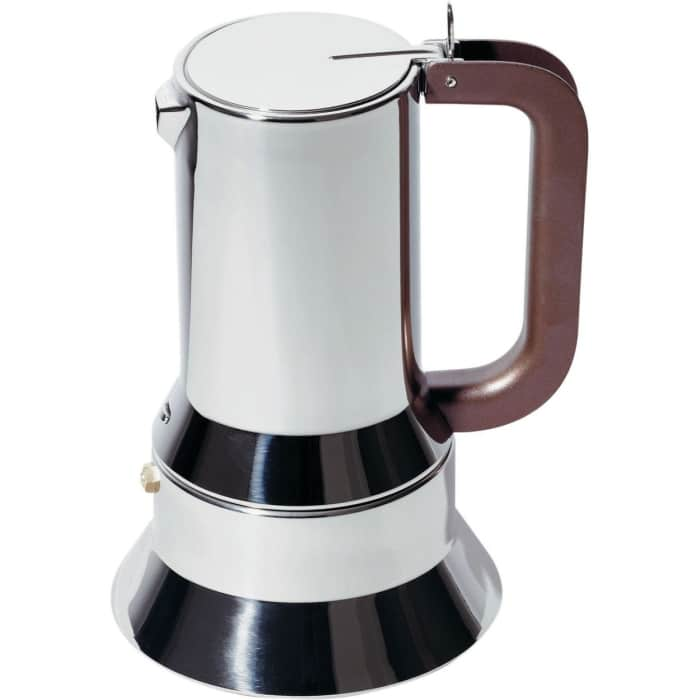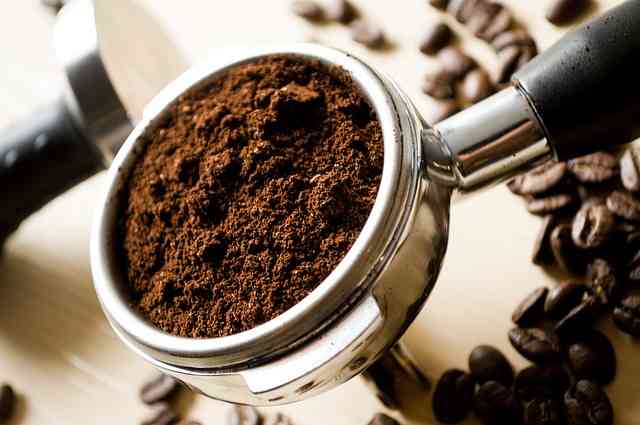The Best Stove Top Espresso Makers: A Beginner's Guide
Paul's passion for making and consuming coffee extends back over thirty years. An extensive traveler, he currently lives in Florida.

The 9090 by RIchard Shapper. If sheer quality is what you are after and don't mind paying for it, then this maker is difficult to beat. Beautifully designed and constructed, it looks as awesome as it performs - an outstanding paragon of design.
Even after having been a coffee lover for thirty years, I still find the evocative aroma of fresh coffee brewing on the stove to be one of the most wonderful sensory experiences there is. Whether it's first thing in the morning, during a slow afternoon, or following a long day, the taste of freshly brewed coffee is the ultimate combination of relaxation and pick-me-up.
This guide to the best stove top espresso makers has been put together with the aim of respecting a range of budgets, tastes, and requirements. The main consideration, as far as my recommended makers go, is quality and value for money.
The 3 Best Stove Top Espresso Makers
Here are my three choices, I discuss each of them in more detail below.
- The Original Bialetti: Classic Italian Design at an Affordable Price
- The GROSCHE Milano: Modern, Stylish and Functional
- Richard Sapper 9090: The Ultimate Espresso Maker
This style of maker can also be known as Moka pot, Moka coffe maker, or a Cafetera Cubana.

The Bialetti uses a classic design that dates back to the 1930's. It is attractive, functional, affordable, and durable. I currently have the ,6-cup version but there are lots of other sizes available according to needs.
The Original Bialetti: Classic Italian Design at an Affordable Price
The Original Bialetti is an old favorite of mine. I've owned numerous Bialettis of different sizes over the years, starting way back to when I was a university student.
It's a classic design, reliable, practical, and pleasing to look at and hold.
I still have a six cup, although I tend to use it just for outdoors and traveling nowadays, rather than as my main maker.
Original Bialetti Advantages
- If you take good care of it, your Bialetti has the potential to last you a lifetime.
- It follows a tried and tested design that has stood the test of time (the first one was made in 1933).
- They are straightforward to use and clean.
- Available in multiple sizes. I've acquired different sizes over the years, according to where I've been in my life, regarding family size.
- The Bialetti is portable. I've taken mine to work and on road trips in the past.
- They are affordable and offer good value for money.
Original Bialetti Disadvantages
- I've always found Bialettis messy when it comes to pouring. I end up doing it in the sink because they inevitably spill coffee.
- I have become more cautious about using aluminum coffee pots over time. I know that the risk of getting Alzheimer’s disease from using one is very low, but I'd rather just pay the extra and get stainless steel nowadays.
- Stainless steel is also easier to clean and often better looking than aluminum.
- Bialettis can sometimes develop some corrosion issues on the inside over time, I've found.
- They will cease to function effectively if you don't clean them very thoroughly on a regular basis. I've discovered this the hard way!

The Grosche incorporates some of the Bialettt's tried and tested design elements and attempts, with some success, to improve on them.
The GROSCHE Milano: Modern, Stylish and Functional
I have to confess that I encountered the Grosche Milano entirely by luck. I was staying at a friend's place in New Hampshire, so my time with this maker was less than 20 days. This stylish stovetop made a big impression on me and earned my affection and respect, however.
GROSCHE Milano Advantages
- Combination of classic design and modern look.
- Works on all gas and electric stove tops, as well as propane camping stoves.
- Safe handle design that saves your fingers from getting burned.
- Makes excellent coffee in my experience.
- Easy to use and easy to clean.
- Available in different colors.
GROSCHE Milano Disadvantages
- I'm not sure if this really counts as a disadvantage, but I feel I should point out that although the handle looks like it's made of wood in the photos, it's actually constructed from rubber coated heat resistant plastic.

I can safely say that the Richard Sapper 9090 is the best espresso that I've ever used. It's expensive for sure, but a good investment. If you take care to clean and dry it properly after each use, it will last indefinitely.
The Richard Sapper 9090: The Ultimate Espresso Maker
For the past three years I've used a Richard Sapper 9090 as my main stove top maker. I was recommended by a friend. I tried it out and soon after I bought one. I can safely say that it is by far the best maker that I've owned.
Richard Sapper Advantages
- The lever closure used to attach the top to the bottom is easier to use than the screwing design that most makers employ, including the Bialetti models.
- Superior stainless steel body, cast iron handle, just a joy to look at and hold.
- It's solidly built. I know that if I look after this little beauty, it will last for a lifetime.
- Very stable, I've found, thanks to the wide base.
- It works with gas, electric, or ceramic stovetops.
- Last but not least, the Richard Sapper makes excellent coffee.
Richard Sapper Disadvantages
- Way more expensive than the average stovetop maker.
- You always have to hand wash it. The dishwasher is a definite no-no according to the instructions.
- It will overflow if you set the heat too high.
The Main Advantages of Stove Top Espresso Brewers
There are many pluses of this type of brewer over the others, I list some of them below.
- They are relatively affordable to buy, compared to other types of coffee maker.
- They don't take up lots of kitchen storage or counter space.
- They can be used outdoors as well as in the kitchen, all you need is a source of heat - no wires, plug sockets, electric supply—so you can take them with you when traveling, or camping.
- Many coffee connoisseurs believe that they make the best tasting coffee of any method.
- The best makers look attractive and enhance the appearance of a kitchen.
- They are easy to clean and maintain.
- You don't have to keep buying new filter papers, like you do with a drip machine.
- Aluminum and stainless steel stovetop brewers are extremely durable and will easily outlast most electric coffeemakers.

When possible, it is always best to buy your coffee in bean form and grind them yourself just before you brew. That way you will get maximum flavor. The beans should be stored in an airtight container and kept away from extremes of heat and cold.
To me, the smell of fresh-made coffee is one of the greatest inventions.
— Hugh Jackman
What to Look For When Buying a Stove Top Espresso Maker
One question that I have often been asked is what should discerning coffee drinkers look for, when they are seeking to buy the best stovetop espresso makers?
There are a number of main factors to consider, in my experience:
- The espresso maker should look and feel good—if you're anything like me, you are likely to use it every day!
- It should be easy to use and clean—functionality matters!
- It should be well constructed and durable—you want something that is built to last!
- It should be competitively priced—value for money is always desirable!
- It should do its main job effectively and produce tasty espresso coffee!

To obtain the maximum flavor from your beans, you should be careful to store your coffee correctly. Ideally the beans should be kept in an airtight container to protect them from the damp. They should also be kept from extremes of temperature.
Tips on Storing Coffee
Poorly stored coffee will quickly lose its aroma and taste. There are a number of excellent methods to employ to keep it fresh, however, as well as a number of things to avoid.
- Always buy your coffee in bean form, when possible, rather than ready ground. You should aim to grind the beans just before brewing to maximize flavor.
- Store the coffee in an airtight container to keep it away from moisture and protect it from light and heat (see below). The best containers are generally constructed from glass, stainless steel, or ceramic.
- Keep the beans away from extreme heat or cold. Direct sunlight should also be avoided. Somewhere cool and dark is generally best.
- Avoid freezing coffee when possible, as this will diminish the taste. Refrigeration should also be avoided for the same reason.
We want to do a lot of stuff; we're not in great shape. We didn't get a good night's sleep. We're a little depressed. Coffee solves all these problems in one delightful little cup.
— Jerry Seinfeld
A Brief History of the "Moka Pot"
Moka pot coffeemakers produce coffee by pushing pressurized steam, created from boiling water, through ground coffee.
This style of coffeemaker is often used in Europe and Latin America and was first patented in 1933 in Italy, by the inventor Luigi De Ponti for Alfonso Bialetti.
The distinctive Bialetti design, functional and attractive with its octagonal shape, is considered by many to be iconic.
The original moka pot was constructed from aluminum with bakelite handles. Many modern makers still use a similar design and construction materials.

It's important to remember when making an espresso that it's not just the coffee making that you have to be concerned with if you want cafe standard beverages. The milk needs to be suitably frothy for the optimum consistency and taste.
Tip: You Should Also Consider Buying a Milk Frother
A great tasting latte or cappuccino is more than just about having aromatic and flavorsome coffee. You need to get the milk just right too, which is not as straightforward as it might first appear!
That means you should seriously consider buying a milk frother too.
There are two main types of frother.
- The hand held type normally takes the form of a propeller on a stem which you dip into your milk. They are typically battery operated. If you are buying a hand held milk frother, then you may also want to consider buying a milk frothing pitcher too.
- Electric milk frothers are more expensive, but worth it in many ways. These are typically metal pots/pitchers which froth the milk internally and then keep it heated. They are easier to operate than hand helds and they effectively operate as pitchers too!
I personally use a Secura automatic frother, which I am very content with overall, the only downside being that it tends to overflow if I overfill it.
This content is accurate and true to the best of the author’s knowledge and is not meant to substitute for formal and individualized advice from a qualified professional.
© 2011 Paul Goodman
Comments
Paul Goodman from Florida USA on June 26, 2012:
You've highlighted some beautiful stovetop espresso makers! I used to have a Bialetti, which is a classic design and worked well - unfortunately an ex of mine borrowed it and never gave me it back! I might go for the Cuisinox Roma as a replacement, I have heard good things about them and I fancy a change.
David on February 02, 2012:
Thanks for your top 5. I've ordered an Alessi 9090 6 cup to replace my Atomic, which doesn't work on my new Induction hob















